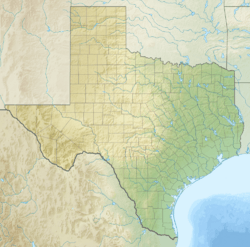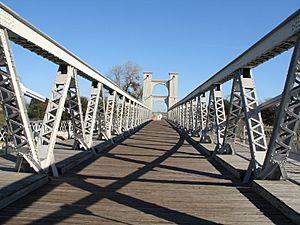Waco Suspension Bridge facts for kids
Quick facts for kids Waco Suspension Bridge |
|
|---|---|

Waco Suspension Bridge in 2007
|
|
| Carries | Foot traffic (Vehicles, stagecoaches, and cattle until 1971) |
| Crosses | Brazos River |
| Locale | Bridge St., Waco, Texas, United States |
| Characteristics | |
| Design | Suspension bridge |
| Longest span | 475 feet (145 m) |
| History | |
| Architect | Thomas M. Griffith |
| Constructed by | John A. Roebling Co. |
| Opened | 1870 |
|
Waco Suspension Bridge
|
|
| Area | 8 acres (3.2 ha) |
| Built | 1870 |
| NRHP reference No. | 70000850 |
| Significant dates | |
| Added to NRHP | June 22, 1970 |
The Waco Suspension Bridge is a famous landmark in Waco, Texas. This amazing suspension bridge crosses the Brazos River. It opened way back on November 20, 1869, making it one of the oldest bridges of its kind. The main part of the bridge stretches 475 feet (145 meters) across the river.
You can find the bridge just north of Downtown Waco. It connects Indian Spring Park on one side of the river with Doris D. Miller Park on the other. Indian Spring Park is a special place because it's where the town of Waco first began. The Huaco Native Americans used to live there, near a cool spring. Today, the bridge is a popular spot. Every year on Independence Day, many people gather there to watch fireworks.
Contents
Building a Bridge: A Big Challenge
Before this bridge was built, crossing the Brazos River was really hard. People had to use a ferry, which was slow and sometimes dangerous. Waco was growing fast, especially because of the Chisholm Trail, a path used for moving cattle. Business owners knew a bridge was needed to help trade and travel.
Planning the Project
Members of the Waco Masonic Lodge #92 thought of building the bridge. They created the Waco Bridge Company to raise money and manage the project. In 1866, they received official permission from the state to build it.
Col. John T. Flint, a lawyer and banker from Austin, moved to Waco. He went all the way to New York to arrange the contract for the bridge.
Overcoming Building Difficulties
In October 1868, engineer Thomas M. Griffith started supervising the construction. He used strong cables made by the Roebling company from New Jersey. Building the bridge was very difficult because Waco was so far away from everything.
Getting Materials to Waco
Getting building materials to Waco was a huge task. There were no machine shops nearby. The closest railroad was 100 miles (161 km) away. The nearest town with skilled workers was Galveston, over 212 miles (341 km) away.
Supplies were loaded onto a steamer in Galveston. They traveled by river to Bryan. From Bryan, the materials were put onto wagons pulled by oxen. The dirt roads from Bryan to Waco were full of potholes and very rough, even for that time.
Amazing Towers
The two large towers that held up the bridge were a marvel of engineering. They were built using almost 3 million bricks, all made right there in Waco.
The Bridge's Early Days
The Waco Suspension Bridge began collecting tolls on January 1, 1870. Its 475-foot (145-meter) span made it the first major suspension bridge in Texas.
The bridge was wide enough for two stagecoaches to pass each other. Cattle could cross on one side, while people walked on the other. Since it was the only bridge across the Brazos River, the company quickly earned back the $141,000 it cost to build. They charged 5 cents for each head of cattle and also for people walking across.
Changes Over Time
In 1889, McLennan County bought the bridge. They stopped charging tolls, making it free for everyone to cross.
Between 1913 and 1914, the bridge went through a major upgrade. Older steel parts were replaced with stronger ones. New support structures, called trusses, were added to help the bridge carry heavier vehicles. This upgrade also included a new walkway for people.
A Historic Landmark Today
By 1971, the Waco Suspension Bridge had been used for over 100 years. It started as a bridge mainly for cattle and became a busy road bridge. The state historical committee decided it was time for the bridge to retire from vehicle traffic. Newer, safer bridges had been built.
The bridge played a huge role in Waco's growth. It helped transform Waco from a small frontier town into an important business center.
Today, the bridge is only open for people to walk across. It is listed on the National Register of Historic Places, recognizing its importance in history.




